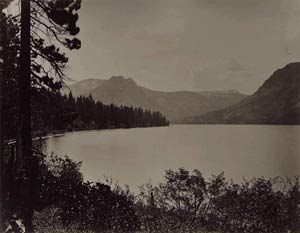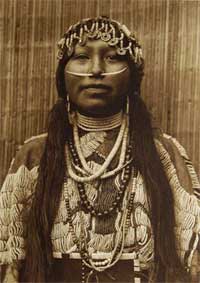"World in a Frame" exhibit highlights photography from exploration age
BERKELEY – An exhibit of 35 photographic prints from pioneering photographers such as Carleton E. Watkins, Edward S. Curtis and others who recorded the American West and the world around the turn of the 20th century opens Friday, March 7, at the University of California, Berkeley's Phoebe S. Hearst Museum of Anthropology.
"The World in a Frame: Photographs from the Great Age of Exploration, 1865-1915," captures an era when photography and exploration intersected to provide the first visual images of many peoples, cultures and landscapes.
All of the photos on display come from the museum's collection, which includes 140 photos by Watkins, recently rediscovered as one of the best photographers of his time.
 Fallen Leak Lake, near Lake Tahoe, California; ca. 1871-73, by Carleton E. Watkins (Courtesy Phoebe A. Hearst Museum of Anthropology) |
His mammoth photographs, measuring 18 by 22 inches, feature such sites as Rock Bluffs along the Columbia River in Oregon around 1881, and a pristine Fallen Leaf Lake near Lake Tahoe around 1871. These photos are not enlargements, but were printed directly from negatives measuring the same size. Watkins' gear was so large that he used a rail car to transport it.
On Watkins' first trip to Yosemite, he took photos that helped persuade the U.S. Congress to preserve the area as a national park.
Another photographer whose work is on display is Timothy O'Sullivan, one of the first to record prehistoric ruins, Navajo weavers and pueblos of the Southwest.
 Wishram girl; Washington, 1910, by Edward S. Curtis. (Courtesy Phoebe A. Hearst Museum of Anthropology) |
The photos of the most famous photographer of the American Indian, Edward S. Curtis, also are on display. Curtis aimed to document what he saw as the vanishing culture of the American Indian and assembled a collection of more than 40,000 negatives. Much of his work is characterized not just by its artistic or scientific base, but also by a softly focused romanticism sometimes aided by props and staging.
The Hearst exhibit remains open through March 2004. The gallery will be rotated in the fall to display a second set of prints from the museum's extensive photographic collections. The exhibit is available online.
All of Carleton Watkins' photos in the Hearst collection are also accessible online through the California Digital Library.
The Hearst Museum is located in Kroeber Hall, near the intersection of Bancroft Way and College Avenue. It is open from10 a.m.- 4:30 p.m. Wednesday through Saturday, and from noon to 4:30 p.m. on Sundays.
Admission is $2 for adults, $1 for seniors, and 50 cents for children 16 and under. Admission is free for museum members, UC students, staff and faculty, and it is free to the public on Thursdays.

